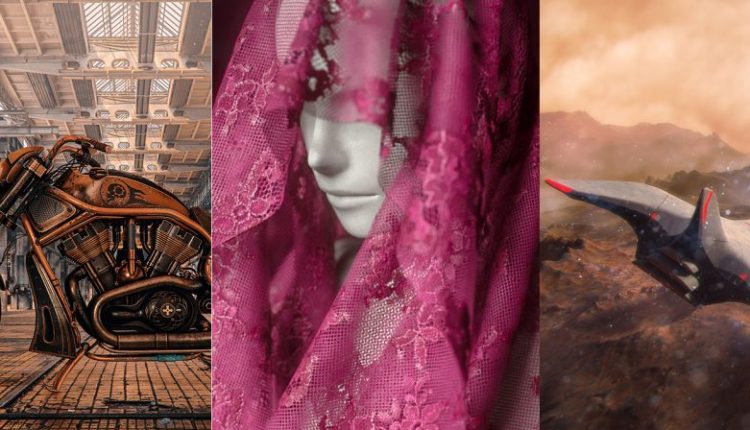Gaming Technology is changing design & visualize products
The ability to render in real-time using game engine technology, together with the consistency and photorealism provided by PBR, have also brought breakthroughs in the way movie and TV studios create content.
More video content is being created using real-time gaming pipelines, either for TV series, real-time green screen compositing in TV shows, or full-on CG movies. The speed of iteration and the consequent cost savings have been driving this transformation, and the creation experience is more fun when removing wait-and-see operations, making these new workflows similar to digital puppeteering.
Among Adobe’s video production tools, Adobe After Effects already offers capabilities for compositing 3D and 2D content. Adobe is planning to develop additional workflows to make video compositing a more immediate and seamless experience. By expanding the 3D capabilities in After Effects, it will be possible to bring 3D content textured in Substance tools directly into After Effects and composite 3D and 2D content in real-time, with the true photorealism required by the film and VFX industry.
Embracing Substance and PBR as the industry standard
Three years ago, Adobe introduced a standard PBR material developed jointly with Atlas. That standard is used in Adobe Dimension, Project Aero, Adobe Capture, every 3D material in Adobe Stock and is broadly supported by Substance tools.
With the acquisition of Atlas, Adobe will also broaden the integration of the Substance SDK in its products, making Substance even more of a worldwide standard for materials. For example, the Substance SDK is already used inside Adobe Capture, the first app on the market capable of creating a PBR material in real-time from a single photo. Substance SDK is also integrated with the industry’s most used 3D tools and engines and provides a unique interoperability.
With PBR as a material standard and Substance as its editing format, Adobe is bringing a unified material pipeline for gaming, film, product visualization and design to the world.
What it means for immersive media
Adobe recently previewed Project Aero, a new multi-platform system for authoring Augmented Reality (AR) experiences. AR is a natural domain extension for Adobe as it expands the concept of compositing. Photoshop and After Effects are the most established tools for image and video compositing, respectively, while Aero brings compositing to the real world and to real time. Photorealism is a crucial need for AR as it allows the perfect blend of the real and the virtual, making the AR experience not only believable but also easier and more intuitive.
The Aero engine uses PBR as its primary material type, leveraging machine learning technology in the lighting space to bring the best photorealism and making real and virtual objects indistinguishable in AR. The existing workflow between Substance Painter and Dimension is currently the best way to bring 3D models with PBR materials into Aero, and more workflows will follow.
Conclusions
After conquering the gaming industry, Atlas’s tools are rapidly spreading to film, design, product visualization and marketing, with massive time and cost savings.
It is no surprise that gaming and VFX are the leading industries for high-end 3D visualization. The final product is digital and moving to 3D has been a necessity. We’re now seeing more and more innovation emerge in other industries traditionally more focused on physical products and product design, like CPG, apparel, retail, packaging, and more.
Today, products are very often designed in 3D, but with a number of workarounds that make the process more difficult and time-consuming: the designer iterating on the next set of colorways often has to go back to a 2D workflow, the merchandiser laying out the store design has to fake the assortment by compositing renders in Photoshop, and the UX designer working on the next version of the e-commerce page or AR application has to redevelop the assets from scratch. With Atlas’ tools, companies can now leverage the 3D models of their product across the entire customer experience – from e-commerce content to marketing material, from catalogues to immersive experiences.
Adobe has been working with Atlas since 2015 to help develop and expand the reach of these authoring capabilities. Adobe Creative Cloud has long been the leader in providing creators with the capabilities they need across media formats, and today, we are enhancing 3D content creation and design capabilities with the acquisition of Atlas, the industry standard for 3D texturing and material creation. By combining Adobe’s industry-leading imaging, video and motion graphics tools with Atlas’ 3D design tools, Adobe will empower designers, VFX artists working in film and television, video game creators, advertisers and more to deliver powerful, interactive experiences while reducing cost and time-to-market.
Appendix
Physics Based Rendering (PBR): Physics Based Rendering is a subset of computer-generated imagery that uses empirically-derived shading models. In practical terms, instead of hacking the “look” of a 3D scene using custom shaders, we agree on leveraging the law of physics (e.g. energy conservation) to describe how the light bounces off 3D objects and develop material maps that describe the relevant properties (e.g. roughness, translucency, shininess, etc.). PBR is valuable because it provides consistent rendering across applications, does not require writing shader code, and provides photorealistic results.


